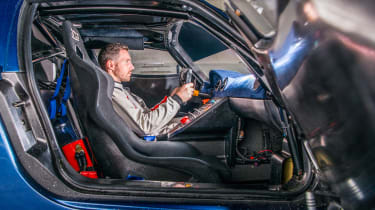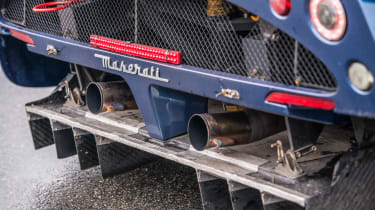Maserati MC12 Versione Corse review – Maserati's Enzo tested on track
Maserati's Ferrari Enzo-based homologation special is as special as it reads on paper, it's a truly spectacular machine
The seating position of the Maserati MC12 Versione Corse is heavily reclined, you feel less like the driver of a car and more like an astronaut ready for launch. The steering wheel, ugly to look at with its chunky, tacked-on digital display but so perfect to hold, reaches to within a hand’s span of your sternum. Strapped tightly into the bucket seat with your feet stretched way out ahead, you peer through the letter-box windscreen, the gap between the thick black sun-strip above and the blue-trimmed dash below scarcely more than a few inches. It looks vast, fearsome and daunting from the outside but, within the cabin, the Maserati MC12 Versione Corse feels so very right.
How we scoffed when Ferrari first announced its FXX programme back in 2005. The idea that anyone could be both rich enough and dumb enough to hand over a seven-figure sum for a car they couldn’t drive on the road, or race, or take home with them, or even wheel out as and when they wanted to... it was absurd. Ferrari, we all agreed, had finally lost its marbles.
Just over a decade later, the trackday hypercar sector has proven to be so successful that it’s grown into a small industry in its own right. Maranello wrote the rulebook with its Corse Clienti programme and it still plays the game today, selling the £2million, LaFerrari- based FXX K to its wealthiest handpicked customers. McLaren and Aston Martin have also got in on the action with the P1 GTR and Vulcan respectively, but in the next couple of years the sector will be elevated to new, Formula 1-derived heights.
Mercedes-AMG has announced Project One, a carbonfibre warhead that borrows its powertrain from Lewis Hamilton’s F1 car, while Aston has teamed up with Red Bull and aerodynamic hyperbrain Adrian Newey – the finest racing car designer of his generation, perhaps of all time – to produce the Valkyrie. Both cars, incidentally, will be homologated for the road, but the track will be where they really belong.
More reviews
Group tests
- Alpine A290 v Alpine A110 – how much DNA do they really share?
- Ariel Atom 4R v Caterham Seven ‘evo25’: power-to-weight heroes go head-to-head
- Caterham Super Seven 600 v Super Seven 2000
- Levante v T1
- Corvette Stingray v Porsche Cayman GTS v Audi R8 RWD
- Great Ferrari hypercars driven: 288 GTO, F40, F50 and Enzo head-to-head
- Hardcore Ferrari V8 specials go head-to-head
- Lamborghini Aventador Ultimae v Lamborghini Countach
- Lotus Emira v Morgan Plus Four – four-cylinder Brits go head-to-head
- Toyota GR86 v BBR Mazda MX-5: supercharged drop-top battles sports coupe
In-depth reviews
- Abarth 600e 2025 review – Italy gives the Alpine A290 something to worry about
- Alpine A110 review – distinctive, lightweight and unforgettable to drive
- Audi R8 (2015 - 2024) review – the ultimate soft-focus supercar
- Bentley Continental R Mulliner: review, history and specs
- BMW 5-series review – is this still Munich’s anchor model?
- BMW 1-series review – Munich’s Audi A3 rival gains focus
Long term tests
- Abarth 695C Turismo Fast Fleet test – 10,000 miles in the Italian hot hatch
- Alfa Romeo Giulia Veloce Fast Fleet test – 7000 miles in the sharp Italian saloon
- Alpina B10: end of term report
- Alpina B10
- Ford Mustang GT
- Ford Mustang GT
- Ford Mustang GT
- Land Rover Defender 110 Fast Fleet test – 9000 miles in the go-anywhere SUV
- Maserati Ghibli Trofeo Fast Fleet test – 4000 miles in the Ferrari-powered saloon
- Mitsubishi Evo MR 340
Review
- New Aston Martin DBS 770 Ultimate review – 759bhp super-GT driven
- New Bentley Batur 2023 review – can it possibly be worth £1.65m?
- 2023 Chevrolet Corvette C8 Z06 review – the American 911 GT3?
- Kia EV6 GT-Line S prototype review – the EV that shows how it’s done
- BBR Supercharged Mazda MX-5 (ND) 2023 review – tuned 250bhp roadster driven
- MG4 Trophy 2023 review
Reviews
- Abarth 695 75 Anniversario edition 2024 review – a fitting send-off for Abarth’s hot supermini?
- Abarth 500e 2023 review
- AC Cobra 378 Superblower MkIV 2021 review – another V8 Cobra, but with a GM heart this time
- Acura Integra Type S 2024 review – a Honda Civic Type R with added restraint
- Alfa Romeo Giulia 2025 review – get one while you still can
- Alfa Romeo SZ: history, review and specs of an icon
- Alfa Romeo 1750 TBi
- Alpina B3 GT Touring 2025 review – a 190mph alternative to the BMW M3 Touring
Having seemed so unlikely a decade ago, the sector has lifted off like a Saturn V rocket in recent years. Manufacturers have realised that the world’s billionaire petrolheads will readily stump up well over £2million for a track car, just as long as there’s some sort of thou-shall-not-surpass überbrag attached to it. ‘That Newey fella designed my car.’ ‘Mine’s got Hamilton’s motor in it.’ And so forth.
Maserati isn’t involved in the supercar game these days, never mind the trackday hypercar business, but back in 2006 it was right in at the ground floor, along with its sister marque, Ferrari. The MC12 Versione Corse was built to celebrate the company’s FIA GT Manufacturers’ Cup success in 2005. That was the official line, at least; the opportunity to flog a handful of cars for a million nicker apiece might also have had something to do with it.
The Versione Corse was based on the MC12 road car but used the drivetrain and suspension from the GT1 racer. Only 12 were built. Maserati stored, maintained and transported the cars itself to begin with, but over the years most have found their way into private collections. Maserati admits it doesn’t know exactly where each of the 12 cars is today, but it reckons four are in the US with the rest dotted around Europe.
‘We let the customers keep their cars, not like our friends at Ferrari,’ says Maserati motorsport sales and marketing manager Roberto Bozzi, who worked on the Versione Corse programme in 2006. ‘We leave them free to use it how they want, to keep it in their garage, or in their living room...’
The MC12 was derived from the Ferrari Enzo, which means the Version Corse is also a close relation of the original Ferrari FXX. It’s based around a carbonfibre tub with inboard suspension, carbonfibre bodywork and Brembo carbon-ceramic brakes.
The 6-litre V12 was upgraded to race-spec to produce a mighty 745bhp at 8000rpm. That’s 124bhp more than the road car and more still than the GT1 racing car, which was fitted with an intake restrictor. The gearbox is a six-speed sequential, the car has no traction or stability control, or even any ABS, and with a dry weight of just 1150kg it has a similar power-to-weight ratio to the McLaren P1 GTR. Most were painted Blue Victory, including this one, and values today are in excess of £2million. Bozzi reckons three have been converted for road use.
Maserati doesn’t like to unwrap its own Versione Corse very often, so it’s a privilege to get any sort of access, let alone to actually drive it. We’re at the Fiat Group’s Balocco test facility, halfway between Milan and Turin, using a track that’s made up of long banked sweepers, endless straights and a wriggly infield section. There’s plenty to hit.
I don’t have good enough karma that I should get to drive a true unicorn car and have decent weather all at the same time, so it’s raining. Not heavily, but it hasn’t stopped all morning and the track is sodden. Maserati has provided a GranTurismo GT4 car for me to learn the circuit in, but even on wet-weather racing tyres there’s almost no grip out there. The car doesn’t want to turn in; a lack of steering feel leaves me wondering if the column has been sheared in half. It doesn’t have much traction, either, and there’s so little feel through the brake pedal that I only know the wheels are locking up because I sail hopelessly past just about every turn-in point.
I slip and slide around like this for a few laps, concentrating mostly on not spinning the GT4 into a field or backing it into a bridge support, all the while learning precious little about the circuit itself. Soon enough it’s time to exit the GranTursimo, contort myself through the Versione Corse’s tiny door and fire up an engine that has just about twice the horsepower. Oh well. It’ll be quite a way to go.
The big V12 fires up behind me and the whole car fizzes with energy. As with the GT4, the MC12 has a centrifugal clutch, which means pulling away is simply a case of selecting first with the steering-wheel paddle and squeezing the throttle pedal. I potter away from the holding area and accelerate gently onto the banked left-hander, pulling for the next gear, then the next. My right foot is flat now, engine starting to howl, up through fourth and fifth, then onto the long straight. Holy hell, this thing is completely planted! Where the GT4 was spinning its wheels up and jinking this way and that, the Versione Corse is glued to the track surface.
Brake hard for the chicane at the end of the straight. The MC12 doesn’t have ABS but I can hit the brake pedal with as much force as my leg can muster and the car just hauls itself down to crawling speed, no locking or snatching whatsoever. Turn in. The steering is light, direct and dripping with feel, the front end immediately responsive, with good grip and no push.
The car feels stable and settled mid- corner, then once on the power I can open the throttle all the way in second gear without a trace of wheelspin. It just picks up and goes, engine revving out to 8000rpm gear after gear. Like the GT4, the MC12 is on rain tyres, but were it not for the spray, the shiny tarmac and the wiper dashing back and forth across the screen in front of me, I’d swear the track was dry.
With its GT1-derived chassis, the Corse is a proper competition machine, not just a road car that’s been modified for the circuit. In these soggy conditions the difference between the two is enormous. One fills you with terror, the other with confidence.
I head back to the garage, shut the car down and climb out for a breather. Where before I was nervous and uptight, I now feel relieved and relaxed. I gather my thoughts, pull my helmet back on and drop in for another go. Time to have a bit of a push.
A banked left-hand bend feeds onto a one-kilometre straight. The conditions are so dank and misty that I can’t see the brake- boards until I’m almost upon them, but with so much grip under deceleration and such rock-solid stability, I’d have to have my eyes shut to out-brake myself. I dare to brake later into each corner, to carry more speed in and get on the power sooner at each exit. The car just takes it all, completely unfazed. In the high-speed sweepers, the massive aerodynamic downforce presses it into the surface, making it feel secure and sure- footed, and in the tighter corners it feels balanced and composed, more nimble than its vast proportions would suggest. It’s only when I really start digging deep that I start to find the limit – a flick of oversteer, a flare of wheelspin. Even in these conditions, the car’s abilities far outreach my own.
Like all these track-focused customer cars, the Versione Corse was designed to be driven by amateurs, not professional racing drivers, so it’s really no effort to pedal and not even particularly intimidating. It isn’t poised on a knife-edge, one misjudged throttle input away from snapping into a spin. Instead it feels benign. It’s only when you try to extract every drop of performance from it that you really have to up your game.
Whether you pootle about timidly or grab it by the scruff, though, there’s always one thing to enjoy about the Corse: its feral, fearsome, wailing, unreconstituted bores- through-your-helmet monster of an engine. From the outside it sounds just like an old Formula 1 V12. Even with my Arai on, the noise of the thing is completely wild, a razor- sharp wail that builds unbearably through the rev-range and reverberates around the small cabin. At 6000rpm, the sound is so intense I have to strain not to flick the paddle to shift up a gear. The shift-lights that run across the top of the steering wheel don’t even begin to light up until 7000rpm and, as they illuminate one after the other and the engine spins harder and harder, it feels like my head is going to burst. At 8000rpm, the final red light flashes brightly and I shift up. It feels more like 12,000rpm.
I’ve been fortunate enough to experience many very fast cars at full acceleration, from heavily turbocharged, torque-rich road cars such as the Porsche 911 Turbo S to 1000bhp all-electric spaceships. There’s a lot to be said for the everything-at-once whack in the back a Turbo S gives you or for the building, uninterrupted pull of an electric car, but nothing compares to a light car with a very powerful, high-revving, naturally aspirated V12 pulling through relatively long ratios. It’s just completely intoxicating, a surge that builds and builds in force as the soundtrack becomes ever more intense, the scenery blurs and the shift-lights flash rudely in your face. Wow. A drink of water, please. I don’t ever want to drive another turbocharged car.
This has to be the most accommodating scary car I’ve ever driven, but, before I can really start to chase it around Balocco, my time is up. Little wonder the concept of the trackday hypercar has become so popular among the one per cent, I think to myself as I climb out of the cockpit. The Maserati MC12 Versione Corse is probably the most amazing car I’ll ever be lucky enough to drive.
Now picture this concept re-imagined for 2020 and beyond, with a grid of GT1 cars based on tomorrow’s hypercars. Over to you, FIA.





